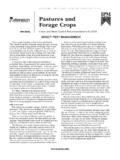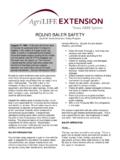Transcription of Teff Grass - High Energy Forages | Soil Building …
1 teff GRASSCal/West Seeds supports the largest commer-cial forage teff Grass breeding program in the In addition to variety improvement, Cal/West and its marketing subsidiary, Producer s Choice, have championed the development and advancement of the best management practices for forage teff at its research stations and in collaboration with public universities and extension agencies all around the guide, authored by Dr. Don Miller, the Producer s Choice Director of Product Devel-opment, has combined the experience and accumulated knowledge of public and private researchers into a practical, easy-to-read, game plan for growers. Dr. Miller was one of the fi rst private breeders to become interested in teff and he has been working with the species since 1995. He has bred several leading varieties, authored the fi rst teff Management Guide, addressed hundreds of producer groups across the and Canada, and coordinates Cal/West s joint teff projects with public universities and extension of ContentsIntroduction.
2 1 Crop Origin ..1 Taxonomy .. 1 Emergence as a Forage Crop ..1 Morphological Description and Growth Habit .. 2 Geographic Adaptation ..2 Crop Utilization ..3 Emergency Forage .. 3 Summer Slump Production .. 3 Double Cropping ..3 Rotation Crop .. 3 Special Uses.. 3 Crop Management .. 4 Temperature Requirements .. 4 Seed Bed Preparation ..4 Fertility Requirements .. 5 Seed Selection ..5 Planters and Planting Rates .. 5 Seeding Depth .. 5 Seeding Date .. 5 Weed Control .. 5 Water Requirements .. 6 Disease and Insects .. 6 Harvest Options .. 7 Harvest Timing and Cutting Management .. 7 Management Checklist .. 7 Yield .. 8 Livestock Uses and Nutritional Value .. 8 The Future and References .. 9Dr. Don MillerTeff Breeder/ResearcherTeff GrassCrop Overview and Forage Production GuideA guide for producers, extension, educators and seed AS A FORAGE CROPINTRODUCTIONTeff is a self-pollinated, warm season annual Grass which can be harvested multiple times during the growing season as dry hay, silage or pasture.
3 As a fast-growing crop, teff combines excellent forage quality with high yield during a relatively short growing season. CROP ORIGINTeff s origin is thought to be Ethiopia, where it emerged as a grain crop for human consumption sometime between 4000 and 1000 Distribution of the crop around the world was initially based on its use as a food grain. Following its North American introduction, teff production centered around its use by ethnic groups familiar with the grain and the niche market for gluten free fl our. teff grain is gluten free, and is a good fl our source for segments of the population suffering from gluten intolerance or Celiac s Disease. Following its initial introduction in the , researchers began evaluating the world collection of teff lines for their forage potential. As a result of the initial work in South Dakota and later at Oregon State, teff s potential as forage was identifi ed. Over the last 10 years teff has gained momentum as a forage crop and several new, improved types have been developed and commercialized.
4 TAXONOMYThe word tef is derived from the Ethio-Semitic root tff , which means lost , possibly a reference to its extremely small seed seed heads showing the genetic diversity of the crop worldwideTaxon: Eragrostis tefFamily: Graminae (Poaceae)Sub Family: EragrostideaeTribe: EragrosteaeGenus: EragrostisSpecies: TefCommon Names: Tef, teff , Lovegrass, Annual Bunch Grass teff , Annual Bunch Grass (Australia), Warm Season Annual Bunch Grass , Williams Lovegrass, Abyssinian Lovegrass, teff grassEMERGENCE AS A FORAGETeff s recent popularity is based on the farmers increasing demand for a summer forage crop that produces high yields with low inputs, without compromising have known for years of teff s forage potential. Seyfu Ketema reports Accord-ing to Burt-Davy (1913), the chief value of teff as a hay crop lies in its palatability, high nutritive value, narrow albumin ratio (for a Grass hay), high yield, rapid growth, drought resistance and ability to smother weeds (in Seyfu Ketema Tef Eragrostis tef (Zucc.))
5 Trotter 1997). As described by early researchers, the interest in teff as a forage crop is due to: 1. Palatability - teff is fi ne stemmed, leafy and soft which is very palatable to livestock. Farmers often report that their livestock pre-fer teff hay over other traditional Grass hays. 2. Fast Growth - Under optimal growing temper-atures and moisture, teff germinates quickly and is ready for early boot stage harvest in 45 to 55 days after seeding. 3. High Yield Coupled with High Quality - Single cut yields are often in the 1 1/2 to 2 1/2 ton range with quality comparable to other high quality Forages such as timothy. In multiple cut areas, summer production of 4 to 7 tons is often obtainable. 4. Summer Production - teff can be planted in late spring and be cut multiple times during the hot summer months. This summer production can provide a source of stored forage for the winter months or fed to bridge the summer slump period of other cool season Grass Drought Tolerance - In areas without supple-mental irrigation, teff can provide forage during times of water defi Wide Adaptation - teff has the ability to thrive in moisture-stressed and waterlogged soils.
6 7. Anti-quality Compounds - teff does not have the anti-quality compounds (nitrate toxicity and prussic acid) that sometimes occur in sorghum-related annuals (Ketema, 1997, Ketema, et al., 1993). 8. Versatility of Harvest - Although in most instances teff forage is baled as dry hay, it can in some operations be grazed, or ensiled. 2 MORPHOLOGICAL DESCRIPTION & GROWTH HABITIt is estimated that in 2008-09 there were approxi-mately 250,000 acres of teff forage production in the , with the largest concentration of acres being in Midwestern and Southeastern states. Research and demonstration plots by leading institutions all across the have demonstrated teff s high yield and high quality potential and acreage is expected to continue to expand. Early examples of forage teff varieties developed in the were Dessie Summer Love Grass (Carl-son, Idaho), 100 (Boe et al. 1986), and Bridger (Eckhoff et al. 1997). Newer forage types such as Corvallis, CW0604 (Cal/West Seeds) and most recently Tiffany teff Grass (PVP) (Cal/West Seeds) are gaining popularity in the DESCRIPTION and GROWTH HABITTeff is a self-pollinated warm season annual Grass with the advantage of a C4 photosynthetic path-way.
7 The teff plant is highly susceptible to frost at all growth stages, and will not survive at temperatures below freezing. Optimal yields are obtained in loca-tions with minimum soil temperatures of 65 degrees Fahrenheit or warmer at planting, and subsequent growing temperatures above 80 degrees. Forage cultivars can be harvested multiple times in a grow-ing season, barring frost. teff is classifi ed as inter-mediate between tropical and temperate grasses, day-length sensitive, and optimal fl owering occurs at 12 hour day-length. Plant height at maturity ranges from 2 1/2 to 3 1/2 feet. It is fi ne stemmed and similar in appearance to bunch grasses. It has a massive, fi brous, shallow diverse root system with small-stemmed tillers originating from one crown. Stems are mostly erect with some cultivars having bending or elbowing plant types. The sheaths of teff are smooth, glabrous, open and distinctly shorter than the internodes. Its ligule is very short and cili-ated while its lamina is slender, narrow and nearly linear with elongated acute tips.
8 It has a panicle type of infl orescence (seed head) showing different forms from loose to compact; its spikelets have 2 to 12 fl orets. Each fl oret has a lemma, palea, three stamens, an ovary and mostly two, in exceptional cases three, feathery stigmas. Floret colors vary from white to dark brown, to maturity varies from 90 to 130 days. The seed is very small, and its color varies from white to dark brown. Number of seeds per pound is approxi-mately million. Fine stems Dense fi brous roots teff Grass stem showing teff Grass paniclesspecies identifyingligule in the circleGEOGRAPHIC ADAPTATIONTeff is adapted to environments ranging from drought stress to water logged soil conditions and diverse soil types. teff production has been re-ported at altitudes from sea level up to 9,186 feet above sea level. teff is classifi ed as a C4 plant which is genetically adapted for growth in hot dry climates. teff and other C4 species such as maize, sorghum and millet, have an evolutionary advantage of a photosynthetic pathway over C3 species such as wheat and cool season grasses.
9 This C4 pathway results in effi cient water use and allows plants to photosynthesize faster under high heat and light conditions than C3 species. Fol-lowing its introduction into North America, teff has been evaluated in public and private trials in the following states and provinces: Arizona, Cali-fornia, Georgia, Idaho, Indiana, Iowa, Kentucky, Kansas, Michigan, Mississippi, Montana, Nevada, New Mexico, New York, Nebraska, North Carolina, Ohio, Oregon, Pennsylvania, Texas, Utah, Virginia, Washington, Wisconsin and Ontario, Canada. teff s performance in these trials indicates a wide range of UTILIZATIONCROP UTILIZATIONEMERGENCY FORAGETeff is an excellent choice as an emergency crop when weather delays the timely planting of grain crops or as a rescue crop, when perennials have failed. It can also be used in years when extreme winterkill has occurred on existing perennial forage crops such as alfalfa or when irrigation water supplies are limited.
10 Under optimal summer growing conditions, teff can provide 1-1/2 to 2-1/2 tons of forage material 45 to 55 days after planting. SUMMER SLUMP PRODUCTIONThe majority of Grass hay production in the and Canada is from cool season perennial grasses such as bluegrass, timothy, orchardgrass and to some extent fescues. These grasses provide the majority of their production during cooler weather of spring or fall but perform poorly during the hot summer months. This requires the livestock producer to use his hay reserves during those periods or rely on supplemental forage production. In the past, crop choices for those low production months have been mainly limited to high yielding but low quality crop alternatives. teff can provide both high for-age yield and quality during this traditional sum-mer slump CROPPINGB ecause teff can be planted from late spring to mid-summer, it is a good double cropping option following cereal grain crops such as wheat.





